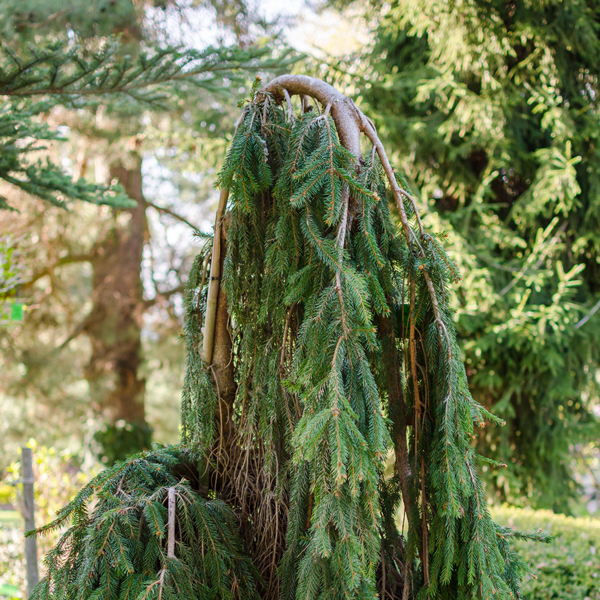
The winter holidays are upon us and Nature’s “winter gift” to us is now on display: Weeping trees. Her decorative autumn “giftwrap” of colorful foliage has fallen away, revealing for our seasonal enjoyment, her present to us – the opportunity to view the shapes of her trees unimpeded by their summer foliage. Now leafless, the trees of the trees of the Winter Garden appeal in new and inspiring ways.
Few shapes in the landscape are more engaging than weeping trees; appearing so different from what we consider a “normal” shape, they tend to draw our eye. For the larger-growing types, the form of their profile against the sky, starkly evident in winter, creates a great focal point in the garden. Others are smaller and slower-growing. Some present an undulating effect, some tend to spread broadly, others hug the ground to follow contours like a groundcover.
Most trees tend to grow in an upright form, spreading their branches upward and outward to capture sunlight. So in some respects weeping trees are “freaks” of nature because their branches grow downward. Weeping trees are unusual in nature, but so many species offer weeping cultivars to add variety to the “ordinary”. You’ll see that most weeping cultivars carry the word “Pendula” in their botanical (Latin) names or “Weeping …” as their cultivar (English) name.
We’re all familiar with the Weeping Willow (Salix), so dominant where it appears in the landscape; few trees rival its grace and form. Other larger-growing deciduous types are Weeping Beech (Fagus), Weeping Katsura (Cercidiphyllum) and Weeping Cherry (Prunus). Large weeping evergreens include Weeping White Pine (Pinus), Weeping Alaskan Cedar (Chamaecyparis) and Weeping Spruces (Picea) and Fir (Abies). All of these need ample space to grow, enabling their form and stature to be properly appreciated as they mature.
And there are lots of other choices, many of which are more refined in growth, well suited even to smaller gardens. Some of my favorite deciduous types for more limited spaces are the Weeping Japanese Maples (Acer), Weeping Redbuds (Cercis), Weeping Dogwoods (Cornus), Weeping Larch (Larix) and Weeping Hornbeam (Carpinus). Some smaller types like Weeping Peashrub (Caragana) and Weeping Dwarf Willows (Salix) are available grafted on top of upright stems to make an attractive patio tree in a container or intimate garden. Even though they can become large after years of growing, the coniferous Weeping Hemlock (Tsuga) and Weeping Atlas Cedar (Cedrus) are readily manageable trees to be a part of most any garden.
With no foliage to disrupt our view of their shapes, winter is the best time to appreciate the variability of form in the deciduous trees in your yard and surrounding landscapes. And even though they retain their foliage all year, the conifers and evergreens are also striking now, standing in contrast to surrounding bare trunks and stems of dormant trees. Winter is certainly a time of rest. But it’s also a season to appreciate all this exceptional beauty of forms that nature offers us.
About the Author
Wayne Mezitt is a 3rd generation nurseryman, a Massachusetts Certified Horticulturist, now chairman of Weston Nurseries of Hopkinton, Chelmsford & Hingham MA, and owner of “Hort-Sense”, a horticultural advisory business. He currently serves in various capacities on several horticulturally-related organizations, including the Massachusetts Horticultural Society at The Gardens at Elm Bank in Wellesley MA, and chairman for the Massachusetts Invasive Plant Advisory Group (MIPAG).









